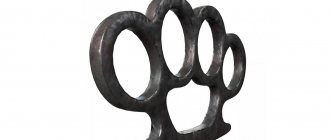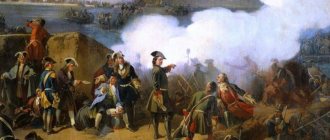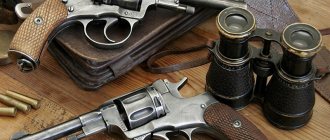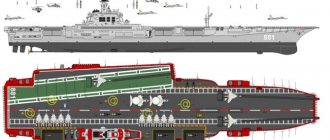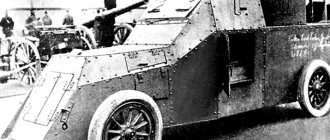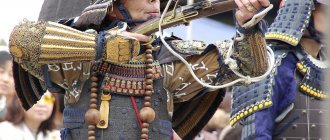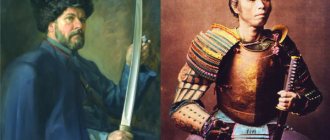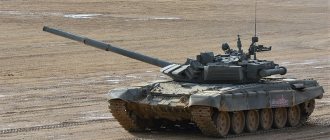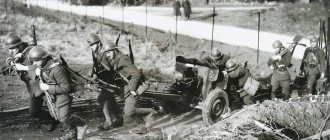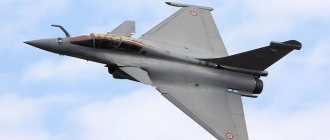A katana is a samurai sword with a curved blade, sharpened on one side, and a straight wooden handle. It was worn and stored in a magnolia sheath.
The size of the weapon is 95-105 cm, the blade is 60.6-75.7 cm, so it is classified as a cold weapon. The cutting part is made of several types of steel, it is both strong and sharp, and holds an edge for a long time. The katana was used in honor fights, held with both hands, but a grip with one hand is also possible.
The cost of an ancient weapon now reaches several thousand dollars; replicas from Japan can be bought for 2.5-60 thousand rubles.
Katana sheath
The sheath of a katana, or saya, is made from magnolia to fit the blade. In cross section they can be oval, in the form of an ellipse or octagon with sharp or rounded edges. The saya is varnished, sometimes it is decorated with ornaments, like on the handle and guard, or covered with fish skin.
The entrance to the scabbard is decorated with horn and bone decor. But if you leave them without any decorations, it will not be a mistake. This is exactly what the saya became during the period when the wearing of a katana was banned by the emperor of the country. Currently, sheaths are also made of metal, but the inner layer must consist of wood.
Shirasaya and Shikomizue
Shirasaya
.
Main article: Shirasaya
Main article: Shikomizue
Shirasaya (
白鞘?
Literally “white scabbard” [])) is similar in appearance to a katana
, although it does not have
a tsuba
(
shirasaya_handguard
) and
tsuka
(handle), without the
same
(lining) and
tsuka-ito.
(stretched) appear to form a single piece of wood next to
the saya
(sheath) as the blade is sheathed, giving it a
bokken-like appearance.
.
Given its limitations, this mount is not considered an effective weapon, but rather a way to store a sword blade. Despite this, a type of weapon designed for combat with these characteristics, the shikomizue
(仕込み杖? literally "prepared staff"),
the shikomizue,
, where these characteristics served the function of disguising the weapon as a cane.
Design
A genuine Japanese sword is made from a specialized Japanese steel called Tamahagane, consisting of a combination of hard high-carbon steel and tough low-carbon steel. Each of these types of steel has its own advantages and disadvantages. High carbon steel is harder and holds an edge better than low carbon steel, but it is also more brittle and can break in combat. Having a small amount of carbon allows the steel to be more malleable, giving the steel the ability to absorb impact energy without breaking but becoming dull with use. Katana manufacturers take advantage of the strengths of both types of steel. This is achieved in many ways, the most common being by making a high carbon steel U-shaped part (the outer blade), and placing a low carbon steel core inside the U-shaped notch, and then heating and hammering the entire structure into a single piece. Some gunsmiths use four different pieces (core, blade, and two side pieces), some even use five pieces.
This assembled blank is heated and forged for several days, then the blank is folded in half and forged again to remove impurities from it. Basically, the katana blade blank is folded no more than 16 times, after which it is forged into the shape of the blade. At this stage, the workpiece is only slightly curved, or not curved at all. The katana receives a slight bend during the process of hardening the blade; the blacksmith covers the blade with several layers of wet clay solution, the recipe of which is different for each katana manufacturer, but mainly consists of clay, water, sometimes ash, powdered stones, and sometimes rust. The blade of the sword is coated with a thinner layer than the sides and back of the blade, then the blade thus prepared is heated and then placed in water (some manufacturers used oil). The clay solution provided thermal insulation, so only the blade's blade was hardened, thereby arching the blade due to the reduction of tension in the crystal lattice on the back of the blade. This process also creates a special uneven line on the blade, called the hamon line, which only becomes visible after polishing the blade; Each jamon is unique and is a kind of signature of the blade smith.
Katana care
They care for the katana using special tools. All actions are performed in strict sequence. First, nicks or deep scratches are removed using polishing stones. Then, with crumpled rice paper (to prevent scratches from large particles), the sword blade is cleaned of old oil. If the katana is very dirty, then lime is added to the rice paper, which removes dirt well and does not scratch the blade. Then, using a new sheet of rice paper, apply a small amount of oil (usually clove oil). A thin layer of oil will protect the blade from rust and dirt.
Making a Japanese katana sword
Traditional katana making is a labor-intensive and lengthy process that includes:
- cleaning steel from unnecessary impurities by immersing it in a solution of clay and ash;
- heating to high temperatures and folding with hammer flattening to obtain a multi-layer sheet of high-carbon material;
- forging, during which steels of different hardness are combined and the outline of the blade is formed;
- hardening of a workpiece coated with a layer of liquid clay so that martensite appears in some areas of the metal;
- release of material that already has the shape of a blade;
- sharpening and polishing, during which the modern Japanese katana sword acquires engraving on the working part;
- making steel guards and decorating them;
- making a handle, connecting it to the blade and guard using a bamboo fastening;
- making wooden scabbards.
Cheap modern samurai swords are made from simple stainless steel with a hardness of 56 HRC. And in this case, the process of creating them is not so complicated, it consists of cutting the blade, hardening, tempering, sharpening, making a handle and sheath, and assembling the product.
How a katana is made in Japan
Katana in Japan is made as follows:
- Pieces of special grade steel are placed in ash and clay solution to remove slag. Then they are removed and heated to join into a single whole, hammered, folded, and the previous step repeated until a sheet of high-carbon steel is obtained.
- A softer material is added to it to impart viscosity, which protects the blade from breakage. Forging takes several days, strips of steel of different hardnesses are combined in the way they will be arranged in the finished product. When the initial form is ready, a layer of liquid clay is applied to it.
- Next, in the process of hardening (heating the workpiece and cooling in warm water), a hamon is formed, that is, a pattern in the area between the blade and the transition to the butt. It will become final after polishing the blade, but first the latter is given a traditional shape - slightly curved.
- The next stage is product release. It is heated in an oven and cooled slowly in air. This is how the blade gains hardness without losing its viscosity.
- The finished metal part of the weapon is sharpened. To do this, use up to 9 special stones of different abrasiveness, and at the end - thin plates or wooden planks. At the same stage, some modern craftsmen apply engraving to the unhardened areas of the blade.
- All that remains is to polish the product. The master also works with different tools, thanks to which he highlights sections of the blade (hamon, hada, etc.). Along with sharpening, the process can last several days.
- Then a handle is made from magnolia or cherry, covered with stingray or shark skin, wrapped with silk, sometimes woolen ribbon. It is attached to the shank using a bamboo pin threaded through a hole on it. Between the handle and the working part of the blade there should be a guard (tsuba), attached using washers (sep). A coupling (futi) should separate the hand protection from the handle.
- The scabbard is made from wood. They are framed with decorations made of animal horn or bone and coated with varnish.
Watch the video about how samurai Katana swords are made:
Preparation and treatment
Katana
blades .
Japanese swords and other cutting weapons were made by a complex method of repeatedly heating, folding and joining metal. This practice arose due to the use of highly contaminated metals.
The distinctive curvature of the katana
partly due to the different warm-up treatment she receives.
Unlike most swords made elsewhere, Japanese smiths do not temper the entire saber; only the side that has the edge. During the hardening process, the tip of the saber shrinks less than untreated steel as it cools, which helps the smith establish the curvature of the saber. The combination of the hard and stubborn side of the katana
and other Japanese sabers is the reason why they are durable despite maintaining a good cutting edge.
To make handling the katana
, there is a type of weapon called
bokken
, shaped like
a katana
, but made of wood, the use of which is used to perfect the movement
of the katana
without danger and thus in combat in training.
Development process
Shows training in the evolution of the katana
.
The steel used today to create katanas is
AISI 1050, as it is the easiest to work with and achieves optimal
hardness
. The ancient Japanese made their own steel using a very slow process in which they fired various layers of iron, coal, and organic material in a closed kiln for over a month. Iron is the main element for making a katana, it is not hard enough, it is more difficult to resist impacts and it is easier to grind its edges into steel to solve this problem.
The master foundry's job was to add about 0.7% carbon to the steel to facilitate the forging process.
In this process, bends are produced by homogenizing the carbon content of the entire block, removing impurities and slag. Successive bending increases the strength of the steel to some extent by organizing the internal structure of the steel into aligned fibers, such as wood fibers.
The steel from which the core of the blade is made is a very low carbon steel, less than 0.15%, resulting in a very ductile and strong ferritic structure.
To make the edge of the blade, it is necessary to use steel with an average carbon content of 0.7%. To achieve this content, the third step in the katana making process is the temple.
Hardening is a process in which the steel material is heated to a temperature slightly above subcritical, about 900 to 950°C, but below the melting point (about 1450 to 1500°C). At this temperature, the internal structure of atoms changes; When re-cooled, the structure regains its original shape, but when cooled rapidly (which is achieved by immersing it in water), structures with a higher carbon content will not be able to recover their original structure and will become very strong. a distorted structure that increases their internal energy and therefore its hardness and resistance. Master smiths covered the blade with clay thick on the side of the spine so that when it hardened, this part would slowly cool and regain its length. Additionally, it could not regain its original length, and it is the difference in length between the back and the blade that creates the katana's characteristic curve.
The core with such a low carbon content is not hardened, maintaining its toughness.
Completion of a katana blade ranges from a month to a year.
With current technology, furnaces heat up very quickly and evenly, but in the past the simple act of raising the furnace temperature to the 900 degrees Celsius required to form steel required an entire month of continuous supply of coal.
The steel that was used (and is still used) is tamahagane, which is broken and its fragments formed into a rectangular brick, which is wrapped in rice paper and liquid clay to prevent oxidation when it begins to heat up. When the heating temperature is reached, it is beaten so that it binds and forms a bonded brick.
The brick is reheated and hammered (during this and the previous process, the blacksmith holding the block hammers and is assisted by one or two assistants using large two-handed hammers), making it thinner and elongated. When it has reached twice its original length, a cut is made right in the middle and it is folded back on itself until it is exactly the same as the original brick, but with two layers of steel between them.
This method of bending the steel is repeated at least 12 times, resulting in a steel brick the same length as the original, but with multiple layers (256 to 4096) of steel bonded together.
This is the method that distinguishes the forging of katanas from the forging of European swords. Carbon impurities, air bubbles and excess carbon are then removed; and the carbon is evenly distributed throughout the blade, eliminating weak spots.
The more times the steel is bent, the better the quality of the steel. The best katanas have up to 3000. During this slow and labor-intensive process, the steel cools quickly, so it must be constantly placed in the furnace to restore the melting point and be able to join the two parts, losing carbon each time this is achieved. temperature.
Thus, the resulting brick has a very low amount of carbon (less than 0.5%) due to this doubling. This steel is quite flexible, allowing it to absorb shock and improve durability in combat, but it may not be hard enough to produce a good cutting edge. The blade of a katana must be very hard, so their second characteristic is used: the use of two steels for the same blade.
Blade and point
of a katana
.
To create the edge, the process uses a second brick with fewer bends (4 to 5 times). This produces a higher carbon steel, making it extremely hard, although also more brittle.
The second brick is cut into pieces that can completely surround the first brick. Place the whole thing in the oven and hit it successively until it reaches the desired length (normally about 80cm).
To give it the typical shape of a katana blade, strike a rectangle until the required width is obtained on the butt (which depends on the type of blade), and then strike part of the blade until it becomes extremely thin (a few millimeters ) so that it can be cut. It also has the shape of a kissakki
(tip) and
nakago
(the part that fits into the handle).
After rough processing with sharpening stones of different grain sizes, which are used to shape the blade, it is hardened. Tempering steel involves raising the temperature of the blade to the austenitizing point and then introducing it into cold water to cool it quickly, which gives the steel extreme hardness. The explanation is that when steel is heated to this temperature, it acquires a completely new structure, called austenitic, and when cooled sharply it acquires a martensitic structure. Great hardness. Impurities in this steel allow the sheet to be tempered after the temperature (at a temperature above the austenitization temperature), also forming a large steel grain. In modern steels this is impossible, since they break from such sudden cooling.
To make the blade extremely hard so that it can cut easily and the spine to be more flexible to withstand the blows it is about to receive, another characteristic of the katana
:
differentiated hardening
.
What is done is to cover the spine with a thick layer of clay (this tempering clay has a composition that varies depending on the forger, and in addition to the clay, sand, iron filings, ash, etc. are added), and leave the edge with a thin layer, which also has contains coal powder.
Everything is heated in the oven and then hardened by putting it in cold water. The root, covered with a large amount of clay, cools much more slowly than the edge, resulting in a hard character for the edge and a softer character for the root. In addition, an elemental effect is created: the steel that hardens faster is “stretched” more softly, giving the blade such a characteristic sori (curvature). Tsuba
de una
katana
.
Hamon, or hardening
, so characteristic of
katanas
, is nothing more than a separation zone between different hardening zones.
Because the clay is placed by hand,
each
katana's
hamon is completely unique.
All that remains is the slow and delicate process of final polishing. It is slow because the blade passes through successive stones that become thinner and thinner, requiring hours of work for every centimeter of the blade, and delicate because inexperienced polishing can disrupt its symmetry. At this point, mekugi-ana is practiced
(
nakago
) where the plug will be inserted to hold it to the handle.
Tsuka
de una
katana
.
katanas can be fully crafted
may take up to a year. The blade is just the first step.
First, you need to do habaki
- a part that serves as a stopper for
the tsuba
, and also serves to bring
the katana
into line with
the saya
.
Habaki can
be made of silver, bronze, copper, brass or steel.
In ancient times, the most used material was bronze. Habaki
forging involved taking a block of bronze, heating it until it became malleable, and then nailing it to the base of the edge of the blade so that it would take the optimal shape of the area to which its assembly belonged. This piece will then be welded to cover the "triangular cylinder" which is the characteristic shape of this component.
Second: you need to make a tsuba
(blade protection).
Its design was made of copper, iron or other metals, with engravings, designs, notches, inlays... When the katana was sheathed, the tsuba
was its visible part, and the one that indicated the status or character of its owner, so again it is delicate process.
Then the tsuka
or a pen.
It is usually made from oak wood covered with the same (ray skin) to improve the placement of ito (strips of cotton, leather or silk) that are woven around the handle, increasing grip and comfort, as well as giving it a typical appearance. . . . To facilitate weaving, paper wedges called hishigamis were used in each bend of the ito. Katana
kon su
shirasaya
y
koshirae
.
Fushi
and
kashira
should also be made of metal, which are usually decorated in the same design and also correspond to
the tsuba
and
menuki
.
Each of these parts is placed at one end of the tsuk to avoid the possible opening of its two parts, since they are glued together only with rice glue. In addition, the ito passes through the kashira
to the opposite side, forming the last knot there, thus also holding the piece tightly.
Menuki is
metal amulets, which can have any shape;
They are placed on the tsuka
, held by the itu, so that they touch the fingers, because they were believed to bring good luck and in many cases were a great family treasure.
The blade is inserted inside and fixed with a metal or bamboo stop to the mekugi-ana
.
Saya ( cover
) is usually made from varnished magnolia wood.
The skirt can also be decorated with strips of rot
(similar to wicker) or pieces
of the same
.
It includes a 1.8 or 2 meter long strip of cotton or leather called sageo
, which is tied to the belt (
obi
)
of the hakama
and can also be used as an auxiliary rope for holding things or for capturing an enemy.
The mouth of the sai
, called
koi-guchi
, is usually reinforced with buffalo horn to avoid wear due to friction with the blade.
Types of katanas and their varieties
There are the following types of katanas:
- traditional;
- wooden, used as a souvenir;
- short - wakizashi;
- straight – kokatana;
- tactical – Tactical Katana Machete;
- with a red blade, where the steel contains gold.
There are also ancient and modern varieties of katanas. But the latter can be of no worse quality than those that have existed for several centuries, since the secrets of their manufacture are preserved and used by Japanese craftsmen.
Wooden katana
A wooden katana is a souvenir weapon used for historical reconstructions or in games. The sword is made entirely of solid beech, including the hilt. Other types of wood can also be used. The handle of the product is trimmed with genuine leather. This katana resembles an ancient samurai weapon only in shape.
Maintenance
The katana must be kept clean and lubricated to prevent the steel from deforming
and didn't break. Sweat, dust or blood affects the blade; Therefore, periodic maintenance is necessary. Currently available on the market are the elements necessary to compose a cleaning kit, which should or may contain:
- An all-metal hammer called a mekugi
. - Koji
lubricating with vegetable oil. - Rice paper, harai gami
. - A ball of non-abrasive powder known as uchiko
. - A soft cloth for maintenance and a plastic storage container known as an erufu
.
Some kits come with a small plastic container to protect the rice paper from the oil.
These items should be kept together and some sets come in a carved or plain wooden box but with kanji lettering
, hinting at the art of war.
Reasons for popularity
In the past, the relevance of the two-handed sword was explained by its convenience, practicality, and durability. Over time, the blade became part of the philosophy of warriors, a symbol of the soul of its owner.
In modern times, weapons are popular among the masses thanks to myths spread through the media and movies - it is believed that the blade cuts through any material, even the most durable. In addition, many are sure that the katana cannot be broken.
Collectors value combat blades made in the past as original, beautiful products with an interesting history.
Japanese weapons are prized by collectors
Main characteristics of katanas
The real characteristics of bladed weapons common in the Japanese archipelago are noticeably different from those presented through movies and anime. This is partly due to the exoticism of the culture, the myths that surround the samurai class. Recent studies have proven that the quality of European blades was often not inferior to those made on the islands. The peculiarity of the katana is the technique of its use, that is, inflicting cutting blows on the enemy and only in rare cases, injections.
Thanks to its shape, the weapon is suitable for quickly making long cuts, and the weight is such that the blade cuts through traditional Japanese armor. It is almost impossible to cut through iron or other material of similar strength.
Katanas are shrouded in myths
Structure
The Japanese sword retains its edge for a long time, is durable and sharp, does not rust, and does not break. These qualities are explained by its structure. Sharpness and hardness are provided by martensite in the composition of steel, but this compound is the cause of brittleness and brittleness of the material. To get rid of the shortcomings, the inner layer was made of low-carbon steel, and high-carbon steel was placed on top. For the work, a U-shaped solid steel bar was used, into which soft metal was welded. Combined timber is a material for forging a workpiece.
Less commonly, a U-shaped piece of soft metal was used, into which hard steel was welded, or additional side inlays were made from a material of medium hardness.
The most famous Japanese blacksmith - Masamune
The larger the sword, the more complex its design. For short blades, one type of metal is sufficient.
Design variations:
- maru (for tanto, wakizashi) - a cheap single blade made of one type of material;
- Kobuse - a simplified design, applicable if you need to make many items of low quality;
- khonsammai - the most common, characterized by side reinforcing plates and guaranteeing the finished item high strength and resistance to breakage due to the absence of hardening of the butt;
- shihozume - a structure with an iron strip to protect the butt;
- makuri - a simplified version with a soft inner bar and a solid hard shell;
- varihatetsu - a flexible simple option;
- orikaeshi sammai – progressive honsammai;
- gomai - a sword with a hard core and a soft shell, additionally protected by hard steel;
- Soshu kitae is the most complex version of 7 layers. Shushu kitae is best known as the work style of the blacksmith Masamune.
Sword steel
The classic option for a katana is refined steel, for the production of which ferrous sand is used, purified under high heat. The result is pure iron. In the past, rectangular Tatara furnaces were used for work, producing iron with a carbon content of 0.6-1.5%. For additional cleaning, a folding technique has been developed - labor-intensive, but giving excellent results. The advantage of the technology is the absence of sulfur and phosphorus in the material, which reduce the quality of steel.
Since the 17th century, the best material for blades in the Japanese archipelago has been namban tetsu - steel imported by Europeans. The weapon contains up to 1.5% carbon and is hard. Thanks to silicon impurities, the blade is flexible and has good impact strength.
Refined steel is used for katana
Straight and slightly curved blades
Straight and curved blades - why are they and is there a fundamental difference?
If you do not go into the details of the bend of the blade, the balance of the center of gravity of the weapon, the distribution of mass around this point, the location of the percussion point, speculation about the purpose of the elmani (expansion towards the end of the saber strip, in the so-called weak part of the blade, in the upper third of the blade from the tip, - Editor's note) and other details - the fundamental difference between the use of straight and slightly curved blades is small.
The features and advantages of a straight double-edged blade with a symmetrical handle are obvious. This is the maximum opportunity to cover the shortest distance to the target and the optimal shape for a direct injection. This is the ability to use a second sharp blade after the first one has become dull or chipped. It is important that the handle is symmetrical, otherwise it will not be possible to turn, hold the weapon and use the second blade.
The advantages of a curved weapon are higher strength (the arch is stronger than a straight beam), the convenience of returning the blade after hitting the target, and the ability to inflict a thrust around obstacles.
As everyone who served in the Soviet army knows, if you put a howitzer on its side, you can shoot from around the corner.
The maximum curved - 30-45 degrees - blades of the Persian shamshir are most convenient to use at a distance of fist fighting; the shape of the weapon allows you to stab the enemy under the crown of the helmet and the hem of the armor, and most importantly - around the kalkan (shield), as if hammering boxing hooks and uppercuts.
On the same topic
Stab or chop: what did the cavalrymen choose?
For saber operation, the optimal handle is one with a smooth reverse S-shaped bend and a beak-shaped pommel, which prevents the weapon from slipping out. In addition, with equal dimensions of straight and curved blades, the latter is much more convenient and faster to remove from the sheath and put into it. For fencing and chopping this is not essential, but for daily wear it is very important.
An essential feature of the use of a saber is the presence of a lanyard (a belt, loop, cord or brush on the hilt of a bladed weapon. - Ed.). I would say more categorically - it is almost impossible to use a one-handed slashing weapon without a lanyard on horseback.
However, the similarities are more significant.
(Photo: David Benzal)
With one-handed blades, cleaving blows are applied with the weapon being carried and returned to the fighting position after closing the circular trajectory. The technique of saber fighting en gross is similar to techniques with a straight one-handed sword, so it is no coincidence that in the English army manuals of the 18th-19th centuries the same masters taught the same actions for the Hungarian saber and the Scottish broadsword. Fencing with a saber and broadsword is, as a rule, the use of feint, working ahead and parade-riposte.
Katana: the history of the samurai sword
From the Joko era (ancient times) to the advent of curved swords
From the Joko era (ancient times) to the advent of curved swords. During the Kofun period, steel swords were already being made. For example, iron swords and tachi have been discovered at the Inariyama Mound, Saitama Prefecture, and the Tsukuriyama Mound, Shimane Prefecture, which is a large square mound in Izumo dating from the early Kofun period. An iron sword with gold inscription excavated from the Inariyama Mound was made in 471 to commemorate the achievements of Wakatakeru (Emperor Yuryaku) using 115 Chinese characters.
Although most swords from this period are damaged, the Kanto Tachi with gold and bronze fittings, excavated in the Kawarake Valley in Yasugi City, Shimane Prefecture, is miraculously well preserved and is known to be a rare case. Most swords after the seventh and eighth centuries retain their original shape well.
Age of Tachi (long sword)
At the end of the Heian period, especially during the Early Nine Years' War and the Late Three Years' War, Tachi developed along with the increasing strength of the samurai. Sword schools appeared on the border between Izumo and Hoki, Bizen Province, where there was good iron sand, and Yamashiro and Yamato Provinces, which were centers of politics and culture. These days the main focus of the katana is the tachi. Representatives of the katana of this period are; The sword "Doji Giri" (killing the ogre), with which Minamoto no Yorimitsu cut Shuten-dōji (Drunken ogre).
Although an ancient document mentions that Yasutsuna from the border region between Izumo and Hoki, who made the sword "Doji-giri", lived in the early 9th century. But from existing works we can conclude that he most likely lived in the middle of the Heian period at the end of the 10th century. Master Yasutsuna, SANJO Kokaji Munechika in Yamashiro (capital) and Tomonari KOBIZEN are considered the oldest sword masters whose names appear on existing works.
Tachi period Kamakura
Although the early Kamakura era katana looked the same as the late Heian period katana, the Kamakura shogunate established a military system of government and the world of swords blossomed. The retired Emperor Gotoba founded the Gotoba-in forge, where he summoned sword masters every month and forced them to forge swords. During this period, the Awataguchi School in Yamashiro Province and the Ishimonji School in Bizen Province were opened. As a result of emphasizing utility, the width of the blade became wider followed by a narrower end. Famous sword masters Kuniyoshi and Yoshimitsu from the Awataguchi school in Yamashiro, Kuniyuki, Rai Kunitoshi and Niji Kunitoshi (only "Kunitoshi" was written instead of "Rai Kunitoshi" as the signature) of the Rai school also in Yamashiro, Shintogoshiro appeared. Kunimitsu in Sagami Province, Fukuoka Ishimonji School in Bizen, Mitsutada of Bizen Osafune School, and Aoe School in Bikchu Province.
Swords made especially in Yamashiro, Yamato, Bizen, Mino and Sagami are called "Gokaden (swords from the five provinces)". The creation of swords in these five provinces respectively has a unique feature in Jitetsu (steel), Kitae (forging) or Hamon (blade pattern), which are respectively called "Yamashiro den (Swords from Yamashiro Province)" or "Sōshu den (Swords from the Province Sagami)." At the end of the Kamakura period, sword making expanded due to disturbances such as the two genko (Mongol invasions) and the collapse of the political system.
The katanas of this period changed, becoming more dynamic than the katanas of the mid-Kamakura era. Tanto (short swords) and other katanas began to have a longer end, like a tachi. It can be said that Okazaki Goro-nyudo Masamune, as an expert in Soshu den, was the most brilliant sword master of that time. His style is seen in the artwork on the surface of the blade, i.e. Kinsuji (gold stripe), Inazuma (lightning) or Chikei (landscape). Masamune's style had a huge influence on swordsmanship in various regions. There are swordsmiths with the title "Masamune Jittetsu (Ten Best Disciples of Masamune)".
After the Muromachi period
At the beginning of the Muromachi period, famous sword masters appeared, including Bizen Osafune Morimitsu and Bizen Osafune Yasumitsu, as well as Moromitsu, Iesuke, Tsuneye also from Bizen. Since most of their swords were made during the Oei period, they are commonly called "Oei Bizen" and are highly prized. Domestic demand for swords had declined since the beginning of the Era of Peace, but the production of important export goods for the Ming Dynasty in China had also begun.
When the war-torn era began due to the turmoil of the Onin War, a number of low-quality swords mass-produced under the name "Kazu-uchi mono" began to appear in response to mass demand, which increased the deterioration of the quality of the swords. The Sengoku period (Warring States period) led to the mass production of low quality mono Kazu-uchi (mass production), but on the other hand, the steel industry that produced this material made rapid advances in Tatara (bellows) technology.
There was a stable supply of high-quality steel. “Jumon-uchi (custom-made items)” and more elaborate Katanas were made, to which warriors could easily entrust their fate. During the Sengoku period, Magoroku Kanemoto and Izuminokami Kanesada emerged as the two main swordsmiths of Sue Koto (Late Old Sword) and Muramasa in Ise. (For swords after the mid-Muromachi era, the Tachi, which was worn on the belt with the blade down, was replaced by the Uchigatana, which was worn at the waist with the blade up.
In history, the creation of swords after the Keicho period is called "Shinto (New Swords)" and is different from the "Koto (Old Swords)" created before that. Famous sword masters gathered in Edo, Kyoto and Osaka to compete with each other.
During the Edo period
Sword fencing flourished. In Edo, Osaka and other regions, famous sword masters emerged, including Kotetsu Nagasone, Kunihiro HORIKAWA, Shinkai INOUE and Sukehiro TSUDA. Although the Katana used to have the attribute of weapon makers, some of them began to develop artistic inclinations. New demand for katana also arose after wealthy merchants ordered luxurious wakizashi (medium-length swords). Especially in Osaka, Shinkai and Sukehiro appeared, who developed a magnificent style called Osaka Shinto (Osaka New Swords). However, conservative samurai avoided some of them because they thought these swords looked decadent and picturesque with an ornate Hamon (blade pattern).
In the era of peace after the Genroku period, there was no demand for new swords, and only a few swordsmiths made swords. On the other hand, however, during this period, sword accessories were developed, such as Tsuba (handguard), Kozuka (auxiliary knife), Menuki (hilt decorations). Among the jewelers appeared many famous swordsmiths, including Matashichi HAYASHI, Yasuchika TSUCHIYA, Toshinaga NARA, Somin YOKOTANI, Shozui HAMANO and Ichijo GOTO.
At the end of the Edo era, when Japan became turbulent, Suishinshi Masahide and some others attempted to revive the Koto (Old Swords) forging method from the revival philosophy, and practical Katana began to be created again. The creation of swords after this period is called "shin Shinto (new-new swords)." Masahide's students appeared, including Shoji Taikei Naotane, MINAMOTO no Kiyomaro, Sa no Yukihide, Munetsugu KOYAMA. However, when sword making began to flourish again, the Meiji Restoration began, then blood feuds were banned in 1873, and the Sword Ban Ordinance was issued on March 28, prohibiting people other than the police and military from carrying swords. From 1876, Katana quickly fell into disrepair.
From the Meiji era to World War II
In 1873, the Katana was exhibited at an exhibition in Vienna. This was to show the international community Japanese technology and mentality. However, after the decree prohibiting the wearing of swords, there was little demand for new swords, and most of the famous blacksmiths lost their jobs. In addition, many famous swords went abroad. However, the Japanese government appointed Gassan and Tadanori MIYAMOTO as members of the Empire of Art. They tried to preserve traditional methods of creating swords. On the other hand, the appreciation of the drawn sword unit during the Seinan War influenced the Japanese Army and Navy to continue to use the katana as the primary weapon for officers, and it became standard to make the katana with military saber-style sword equipment.
After the Manchurian Incident, the Armory and some researchers at the institutes used this capability as soldier equipment. For example, various military swords were studied, including the Shinbuto, which was strong in the harsh cold of Manchuria, and the stainless steel katana used by the navy (Taiseito) was made. Various blade shapes were produced as prototypes or in high quality. These special blades were called "Showa Swords", "New Murata Sword" and "New Katana", and many of them were said to be superior to regular katana (even famous swords) in quality.
After World War II
After the surrender during World War II, a sword hunt was held at the General Headquarters of the Supreme Commander of the Allied Powers, so numerous swords, including Hotarumaru, were destroyed (in Kumamoto Prefecture, for example, swords were burned with gasoline and thrown into the sea). There was also a rumor that "if you have a sword, the headquarters will come looking with a metal detector", so some swords were hidden in the ground, which caused them to corrode and they were destroyed, some were broken, and some people themselves they threw away swords and so on and so forth.
Although the katanas themselves were once endangered, Japan made great efforts and ownership of the registration system became possible. The katana itself must be registered, but a sword without registration must be reported to the police and investigated. Although the carrying of a sword is subject to restrictions under the Sword and Firearms Control Act, a permit is not required to own a sword and anyone can own one (some municipalities prohibit sales to people 18 years of age or younger by ordinance). Today, the katana is not a weapon, but tools for martial arts such as iaido, and worthy art objects such as paintings and ceramics, production and storage are permitted only for such purposes. In addition, there is a quota for the number of swords a sword maker must make per year.
Masamune and Muramasa - great Masters
The first Master is Masamune. Born at the end of the 11th century in the province of Sagami, where he worked. He can rightfully be considered the most famous gunsmith in Japan. He gained fame for creating his own technique for making swords - Soshu. Weapons using this technology were manufactured according to strict canons. The basis of the sword was four strips of steel welded together, which were folded together and forged five times, resulting in the number of layers in the blade becoming 128. This technique was used by more than one generation of his students. According to legend, Masamune refused to sign his blades because they could not be counterfeited.
Second Master - Muramasa. The founder of an entire dynasty of gunsmiths from the Ise province. His swords were famous for their incredible sharpness. The master was dissatisfied with the policy pursued by the then ruler of Japan and put curses for the imperial family into each of his swords. For this reason, in the 17th century, Muramasa swords were banned and destroyed, and the people who kept them were persecuted to the point of death. Perhaps this is why there is a legend that Muramasa swords are bloody swords and can awaken bloodlust in the owner. Only four Muramasa swords have survived to this day, one of which holds the title of the sharpest sword in the world, which consists of 25,000 layers of steel.
These masters are connected by one legend - each of the gunsmiths stuck his sword into the bottom of a river overgrown with lotus, lotus flowers passed unharmed past Masamune's sword, while Muramasa's sword cut them into small pieces. In this fight, Muramasa recognized Masamune’s victory, since according to Japanese philosophy, the sword is not a weapon of aggression, but a weapon of peace and was created to stop wars.
Handmade katana Samurai Sword Katana, price - 5248.37 rubles.
Story
The word "katana" comes from the Japanese reading of the Chinese character 刀, which is otherwise read as "too". For the Japanese, this is a broad concept meaning a one-sided knife, sword. When explaining what a Japanese katana is, I often use the term “nihontoo”, that is, “Japanese sword”. If a sword is sharpened on both sides, it is called tsurugi, ken, but sometimes these terms are used to designate one-sided weapons. This is used more often in fiction. The reason is the many centuries of influence of Chinese culture on the Japanese language and the archipelago’s inhabitants’ ideas about beauty. In China, the sword sharpened on both sides had the highest status, so the term for it in Japan was occasionally used for the katana, thereby showing respect for the object.
Since the 9th century, Japanese warriors have appreciated the advantages of a curved weapon, useful in mounted combat. At the same time, the samurai class appeared, for whom weapons turned into a symbol, an indicator of status, the physical embodiment of ideas and philosophy of life. From the 12th century, the Japanese began to develop improved armor, while simultaneously changing bladed weapons. The swords became heavier and took on a new shape. From this moment on, the katana turns into a two-handed weapon. Historians consider the period of the 12th-14th centuries to be the peak of the katana’s heyday. Since the 14th century, along with the increase in the number of military conflicts, the demand for weapons has increased, while at the same time its quality has decreased.
Traditional samurai weapons
The Japanese blade has existed in its modern form since the 15th century. It was formed in the early Muromachi era from tachi, and was widely used until the end of the 19th century as a traditional samurai weapon with a short wakizashi. You can recognize a traditional sword by its appearance - the hardening line, leather and silk handle.
What is a katana
Classic Japanese weapons are created from several types of steel, refined by folding and boiling. Samurai weapons are a bastard sword, the length of the blade is about 60 cm. The cutting part is usually curved outward. The length of the handle is not regulated. Item weight – 0.75-1 kg.
In addition to the katana, the samurai armed himself with a short wakizashi sword - almost identical to the main one, but shorter in length. There were daggers whose length was half that of the main sword. Both the long and short blades were worn in a sai sheath. This sheath set is made of wood; in the 20th century they began to make metal sheaths with a wooden lining. Their value is noticeably lower, since these are mass-produced items.
Weapons are the pride of a warrior
Advantages and disadvantages
The handles of modern products are richly decorated in a given style.
If we exclude all the myths planted by movies and games, the katana remains a high-quality, but ordinary weapon. The blade took into account the fighting technique of Japanese warriors and evolved in accordance with it.
The advantages of a katana include its lightness and curved shape, which allows for quick cutting blows. The weapon was used as a two-handed or one-handed weapon paired with a short blade. Excellent for fighting opponents unprotected by armor.
The disadvantage of katana is the long forging period and the complexity of manufacturing. High-quality swords were made for samurai, however, they also had certain shortcomings. The thinness of the blade and sharpening made the blade vulnerable to improper impacts on a hard surface. Many surviving blades have chips and nicks, indicating the limited use of the katana.
The katana also does not stand up to comparison with its European contemporary - the bastard sword. Many people consider the Japanese sword to be lighter and faster, but this issue remains controversial. The one-and-a-half blade is only 300-400 grams heavier and is distinguished by its balance and maneuverability.
The blade of the one and a half blade is thicker, the sharpening is not so sharp, however, it is more reliable for long battles and impacts against armor and shields. This also simplifies mastering the European sword, which does not require the beginner to concentrate on the accuracy of the blow.
In this context, the katana is an excellent weapon that became in demand in numerous internecine wars of Japanese feudal lords. However, talk about its exclusivity over any other bladed weapon is nothing more than a myth created by popular culture. In most cases, the advantages and disadvantages of a weapon are determined by its use and the skill of the owner.

